The Lockheed Martin C-130: 63 Years of the Mighty Hercules
Report and photos by Steven Valinski
December 29, 2017
One of the most popular heroes in Greek mythology, Hercules, was known for his tremendous strength, perseverance and his ability to conquer the infamous “12 Labours”.
Much like the mythical character, the Lockheed Martin C-130 Hercules, nicknamed the “Herc” (sometimes spelled: “Herk”), has shown great strength, perseverance and the ability to handle a multitude of challenging missions.
A “Herc” is Born
Born in the early 1950’s out of the need for a transport aircraft specifically designed to carry heavy equipment, artillery, tanks and troops, while being able to fly a slow enough speed for combat parachute drops. The USAF set out to replace the Curtiss C-46 Commando, Fairchild C-82 Packet and the Fairchild C-119 Flying Boxcar at the onset of the Korean War.
- The original requirements for this transport, as defined by the USAF, included:
- The ability to carry 92 infantrymen or 64 paratroopers on a mission with a combat radius of 1,100 nautical miles (1266 miles or 2037 km) or alternatively, 30,000 Ibs (13,608 kg) of cargo more than 960 nautical miles (1105 miles or 1778 km).
- The ability to operate from short, unprepared airstrips of clay, sand, or humus soil.
- The ability to slow down to 125 knots (144 mph or 232 kph) for parachute drops and even slower for assault landings.
- Have both a rear ramp operable in flight for heavy equipment drops and side doors for paratroop drops.
- The ability to handle bulky and heavy equipment including bulldozers, artillery pieces, and trucks.
- The capability to fly with one engine out.
The Lockheed team, led by Willis Hawkins, which also included Art Flock, Dick Pulver, Bill Statler and Gene Frost, had a little over two months to develop a design that met the USAF requirements. Fortunately, by specifying cargo and weight requirements, the USAF helped determine the size of the cargo area and the remainder of the aircraft could be designed around it.
Some key engineering innovations that led to the C-130 included:
- The inclusion of four turboprop engines which helped provide surplus power that contributed to pressurization of the aircraft (including the cargo area), which was necessary to fly efficiently at higher altitudes.
- The strengthening of the airframe to allow for pressurization while adding an extra layer of durability. This led to the C-130’s reputation for resiliency and durability.
Production of two YC-130A prototypes were built at Lockheed’s Burbank plant. The first C-130 to fly (serial number 53-3397) was the second prototype produced. With the exception of the two prototypes, production of the C-130 has taken place at Lockheed Martin’s Murietta, Georgia plant.
The C-130 Hercules has proven to be one of the most widely-used and versatile aircraft ever produced and, what some would say, is the most successful military aircraft in the history of aviation. The C-130 also has the distinction of having the longest continuous production run of any military aircraft in history.

The first flight of the YC-130 prototype on August 23, 1954. Lockheed Martin photo.
The Evolution of the C-130
Pilots of the C-130’s of the 50’s and 60’s would probably say there are substantial differences in the C-130 they flew compared to the C-130 of today. The original C-130, was powered by four Allison T56-A-9 turboprops with three-blade propellers and sported a “roman nose” that would be unrecognizable today. In contrast, today’s Lockheed Martin C-130J Super Hercules models are powered by Rolls-Royce AE 2100 D3 turboprops with Dowty six-blade R391 composite propellers and state-of-the-art avionics with a digital cockpit featuring head-up displays (HUD).
With its inaugural flight on Aug. 23, 1954, and its first production “A” model flight on April 7, 1955, the C-130 Hercules has been roaming the skies around the world for over 63 years. The C-130 has been delivered to 63 nations, is flown by 68 nations and operates in a variety of different roles and missions.
Lockheed Martin Video
The C-130’s ability to operate in different roles and missions can be attributed to the 70+ models, variants or configurations of the C-130 that have flown since the C-130 was first delivered to the USAF in 1956.
These roles/missions/variants include: tactical airlift, aerial tanker, electronic warfare, search & rescue, special operations, humanitarian assistance, basic and VIP transport, reconnaissance, weather reconnaissance, gunship and several others.
Major C-130 Models/Versions
C-130A/B
Deliveries of the “A” models began in December 1956. The C-130A was originally powered by four Allison T56-A-1 turboprop engines, each delivering 3,750 horsepower with each including a three-bladed Curtiss-Wright electric-reversible propeller (later an Aeroproducts three-blade). Early in production, the engines were modified to the T56-A-1A, while later production C-130A’s utilized the T-56-A9 or T-56-A11 engines. The early “A” model aircraft originally had the blunt “Roman” nose that the YC-130 prototypes had.
The USAF determined that the early “A” models lacked range so external pylon-mounted fuel tanks were added at the end of the wings. In addition, a four-bladed Hamilton-Standard propeller replaced the three bladed prop. Later “A” models also had a radar upgrade from the AN/APS-42 weather radar to the improved AN/APN-59 navigational radar, which facilitated the need for a modified nose radome on the C-130A. This led to the distinctive extended radome nose on the aircraft we have seen throughout the C-130’s history. Earlier C-130A’s were retrofitted with the AN/APN-59 and extended nose configuration. In total, 231 “A” models were delivered by Lockheed.
The first “B” models began to be delivered in November 1958. The “B” models saw an addition of an AC electrical system and auxiliary fuel tanks built into the center wing section. The center wing section also received some structural strengthening to reduce the effects of fatigue. The engines were also upgraded to the Allison T56-A-7 and the landing gear was strengthened. Another enhancement was the addition of an extended tail cone which housed an AN/URT-26 Crash Position Indicator (CPI). Lockheed delivered 230 “B” models.
C-130E
With the USAF’s Tactical Air Command (TAC) and the U.S. DoD’s Military Air Transport Service (MATS) growing need for turbine-powered tactical transport at the time, Lockheed improved upon the progress made upgrading the C-130 with the “B” model.
Entering service in June 1961, the C-130E added two underwing fuel tanks which increased the range of the C-130 further. The “E” model also had updated Allison T56-A-T5 turboprop engines.
The C-130E also saw numerous structural improvements and avionics upgrades making it a durable long-range tactical transport. 491 “E” models were delivered.
C-130H (includes H-30)
Entering service in March 1965, and remaining in production until 1996, the “H” model saw an upgrade to Allison T56-A-15 turboprops, an improved center wing, redesigned outer wing, updated avionics and other enhancements.
Due to the long production run of the “H” model, and the numerous upgrades and enhancements that were made to the “H” models throughout the production run, the C-130H is designated by sub-model types of H1, H2 and H3 by the USAF. 1202 “H” models were delivered.
The H-30 is a 15 ft (4.6 m) extended fuselage variant.
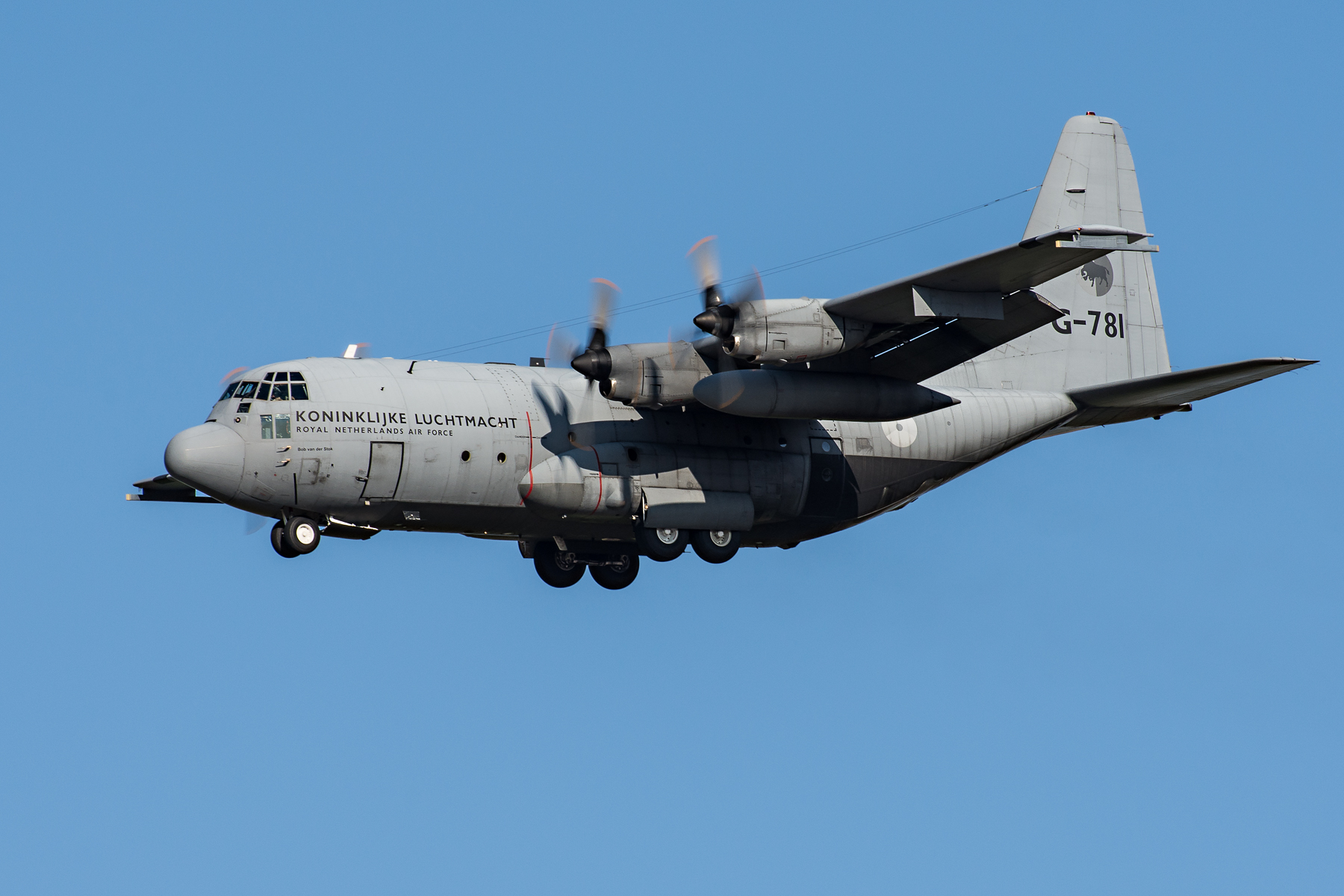
A C-130H from the Royal Netherlands Air Force (RNLAF) (Koninklijke Luchtmacht)
C-130J (includes J-30)
With its first flight in April 1996, and entering service in June 1998, the C-130J Super Hercules marks the most significant upgrade to the C-130 since the 1960’s. As mentioned earlier, C-130J upgrades include: Four 4,700 horsepower Rolls-Royce AE 2100D3 turboprops, six-blade Dowty R391 composite propellers, digital avionics (including head-up displays (HUD) for each pilot), along with reduced crew requirements.
According to Lockheed Martin, “Compared to older C-130s, the J-model climbs faster and higher, flies farther at a higher cruise speed, and takes off and lands in a shorter distance. The C-130J also meets the need to support a wide range of missions with the same platform.”
These upgrades not only show substantial performance improvements over the original C-130 models, but the previous generation “H” models as well. The standard length C-130J Super Hercules shows a 14% improvement in top speed, 26% increase in ceiling, 71% increase in range (normal payload) 23% (with 35,000 pounds of payload) and a 6% increase in maximum takeoff weight as compared to C-130H models.
The J-30, like the H-30, is a 15 ft (4.6 m) extended fuselage variant.
Lockheed Martin Video
Key C-130 Variants
C-130 A/B/E/F/G/H/K/T/J Hercules (A,B,E,F,G,H,K,T) Super Hercules (J,XJ)
Base tactical airlift variant.
C-130 K (C1 & C3) J (C4 & C5)
Royal Air Force (RAF) variant.
CC-130 E/H/H-30/T Hercules (E,H,H-30,T) Super Hercules (J)
Royal Canadian Air Force (RCAF) variant.
AC-130 A/E/H/J/U/W Gunship II, Plain Jane, Surprise Package, Coronet Surprise, Super Chicken, Pave Pronto, Pave Pronto Plus (A)/ Spectre (A,E,H)/ Spooky II (U)/ Ghostrider (J)/ Stinger II (W – MC-130W Dragon Spear conversions)
The AC-130 is the gunship variant of the C-130. Utilized for close air support (CAS) and air interdiction. The AC-130 has been in use since the Vietnam War.
Beginning in 1967 with Project Gunship II, to today’s AC-130J Ghostrider, the AC-130 has been protecting troops for over 48 years. The original AC-130A with its Forward looking infrared (FLIR) camera and Gatling guns evolved into today’s AC-130J with advanced two-pilot flight station with fully integrated digital avionics, dual inertial navigation systems and global positioning system, precision strike package, advanced communications suite, precision guided munitions capability, advanced fire control equipment, 30 mm Bushmaster cannon and M102 105mm howitzer.
The AC-130J is also capable of Air Refueling with the Universal Air Refueling Receptacle Slipway Installation (UARRSI) system.
For defensive purposes, the AC-130J has the Large Aircraft Infra-Red Counter Measures (LAIRCM) system including chaff, flares, and lasers to deter heat-seeking missiles.
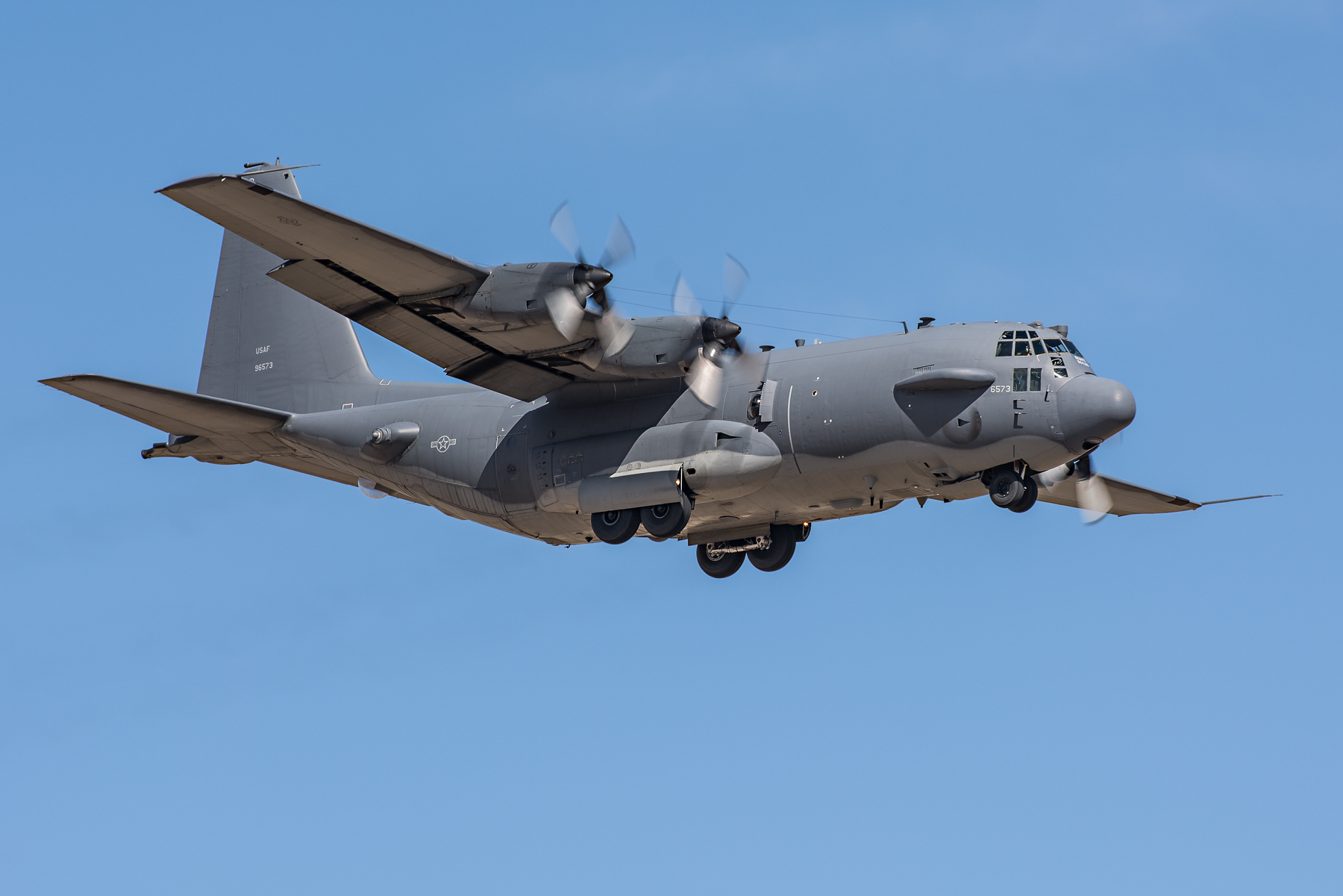
AC-130H Spectre 69–6573 ‘Heavy Metal’ arriving at Davis-Monthan AFB to be retired to AMARG
DC-130 A/E/H
This variant was used to launch, track and control drones. Operated by the USAF and the US Navy, the DC-130 had the ability to deploy four BQM-34 Firebee (and variant) target drones and provide control for up to 16 drones simultaneously.
The DC-130 is no longer flown today.
Outlined in a 2014 RFI, the Defense Advanced Research Projects Agency (DARPA) has been looking into the feasibility of using the C-130 to launch and recover multiple small unmanned air systems so the
EC-130 E/H/J/Q/V Commando Solo (E,J)/ Rivet Rider (E)/ Compass Call (H)
The EC-130 variant includes several special purpose C-130 variants. These variants include:
EC-130H Compass Call – This airborne electronic warfare (AEW) variant is flown by the USAF. It is used to disrupt enemy communications and enemy command and control.
The Compass Call flies with a crew of 13 including: aircraft commander, co-pilot, navigator, flight engineer, acquisition officer, airborne maintenance technician and several linguists and electronic warfare officers.
The EC-130H Compass Call works in conjunction with the EA-6B Prowler/EA-18G Growler and F-16CJ Fighting Falcons to suppress enemy air defenses (SEAD) while jamming communications/radar and disrupting command and control.
The EC-130H Compass Call is currently flown by Air Combat Command’s (ACC) 55th Electronic Combat Group (55 ECG), based at Davis-Monthan AFB, Arizona.
EC-130J Commando Solo III – The Commando Solo conducts Military Information Support Operation (MISO) and civil affairs broadcast missions for the USAF. Also known as psychological operations (PSYOP) missions, the Commando Solo III can specify a target audience and broadcast in AM, FM, HF, TV and various military communications bands.
The EC-130J Commando Solo III flies missions day or night at higher altitudes for optimum broadcast to the target audience.
The Commando Solo III is currently operated by the 193d Special Operations Wing (193 SOW), a unit of the Pennsylvania ANG, based at the Harrisburg Air National Guard Base in Middletown, Pennsylvania.

EC-130H Compass Call from the USAF’s 43d Electronic Combat Squadron
HC-130 B/E/H/P/N/J Combat King (P,N)/ Combat King II (J)
The HC-130 variants are an extended range version of the C-130 used for search and rescue (SAR) and combat search and rescue (CSAR) missions.
The current HC-130J Combat King II, flown by the USAF, is designed to conduct a variety of missions including: airdrop, forward area ground refueling missions, aerial refueling, humanitarian assistance and disaster relief (HA/DR), security cooperation/aviation advisory, emergency aeromedical evacuation, and noncombatant evacuation operations.
The HC-130 is also utilized by the U.S. Coast Guard.

A HC-130J Combat King II from the USAF’s 79th Rescue Squadron (79 RQS)
KC-130 F/R/T/J
The KC-130 is an extended-range tanker version of the C-130. The KC-130 is used for a variety of roles and missions including: aerial refueling and transport missions.
The USMC currently flies the KC-130T and the newer KC-130J.
The KC-130 has 60,000 pound fuel capacity that can be used for its own flight or to provide fuel for other aircraft. The hose and drogue refueling pods can refuel a variety of USMC and US Navy fixed-wing or rotary aircraft at a rate of two aircraft at 300 gallons a minute.
The KC-130J can also perform CAS missions as a gunship by utilizing the Harvest HAWK package.
While the KC-130J is used exclusively by the USMC within the U.S. military, other countries such as Saudi Arabia have adopted the KC-130J as a refueling aircraft. Spain, Israel, Japan, Saudi Arabia, Singapore and others also fly older “KC” refueling variants.

A USMC KC-130J from Marine Aerial Refueler Transport Squadron 152 (VMGR-152) “Sumos”
LC-130 F/H/R
Sometimes referred to as the “Skibird”, the LC-130 is a ski-equipped variant for Arctic and Antarctic support operations. The typical landing gear are supplemented by Teflon-coated skis for landing in snow or ice. LC-130’s are primarily used to transport personnel and/or cargo for scientific expedition support.
Currently, 10 LC-130H’s are operated by 109th AW of the New York ANG based at Stratton Air National Guard Base in Schenectady, New York. Part of the 109th AW’s mission is to support National Science Foundation’s South Pole research program.
A look at the LC-130 “Skibird”. Smithsonian Channel Video
MC-130 E/H/W/P/J Combat Talon I & II (E,H)/ Combat Spear & Dragon Spear (W)/ Combat Shadow (P)/ Commando II (J)
The MC-130 is the special operations variant of the C-130. Originally developed during the Vietnam War to support covert operations, the MC-130 is designed for intrusion in contested territories, refueling of special operations rotorcraft, and infiltration, exfiltration and resupply of special operations forces by airdrop and airland.
With short takeoff and landing (STOL) capabilities, the MC-130 can provide a multitude of support missions for U.S. and coalition partner special operations forces.
According to the USAF, the current MC-130J Commando II: “flies clandestine, or low visibility, single or multi-ship, low-level air refueling missions for special operations helicopters and tiltrotor aircraft, in addition to: infiltration, exfiltration, and resupply of special operations forces (SOF) by airdrop or airland intruding politically sensitive or hostile territories. The MC-130J primarily flies missions at night to reduce probability of visual acquisition and intercept by airborne threats. Its secondary mission includes the airdrop of leaflets.”

A MC-130H Combat Talon II from the USAF’s 15th Special Operations Squadron (15 SOS)
NC-130 A/B/E/H
C-130 variant used for flight testing purposes.
RC-130 A/S
This is the reconnaissance and surveillance variant of the C-130.
SC-130J Sea Hercules (or “Sea Herc”)
Unveiled in 2012, and based on the modern C-130J Super Hercules, the SC-130J is a maritime patrol aircraft that utilizes the Anti-Submarine Warfare (ASW) Mission System.
Designed for high endurance/time on station and efficiency at low altitude, the SC-130J uses a variety of ASW sensors (passive and active) and ASW/Anti-Surface Warfare (ASuW) weapons.
Lockheed has proposed the aircraft to a number of nations including the UK and Canada. The US Navy has not shown an interest due to its investment in the Boeing P-8 Poseidon.
TC-130
Pilot/Crew C-130 training platform.
WC-130 A/B/E/H/J Hurricane Hunter/ Weatherbird (J)
A weather reconnaissance variant of the C-130. The WC-130 utilizes sophisticated weather instrumentation for penetration of tropical disturbances and storms, hurricanes, winter and other types of storms to obtain data on movement, size and intensity.
According to Lockheed Martin, the: “WC-130J usually penetrates hurricanes at an altitude of approximately 10,000 feet to collect meteorological data in the vortex, or eye, of the storm. The data collected by the WC-130J makes the advance warning of hurricanes possible and increases the accuracy of hurricane predictions and warnings by as much as 30 percent.”
MAFFS
The Modular Airborne FireFighting System, or MAFFS, is a self-contained unit that is installed in a C-130 to enable it to act in the role of a fire tanker. This configuration has allowed the U.S. Forest Service to utilize military C-130’s from various Air National Guard and USAF Reserve units.
The current configuration, known as MAFFS II, is utilized by 145th Airlift Wing from Charlotte, North Carolina, 302nd Airlift Wing at Colorado’s Peterson Air Force Base, the 146th Airlift Wing from Port Hueneme, California, the Air National Guard’s 153nd Airlift Wing from Cheyenne, Wyoming and the latest MAFFS-equipped unit, the 152nd Airlift Wing of the Nevada Air National Guard when extra resources are needed to fight forest fires.
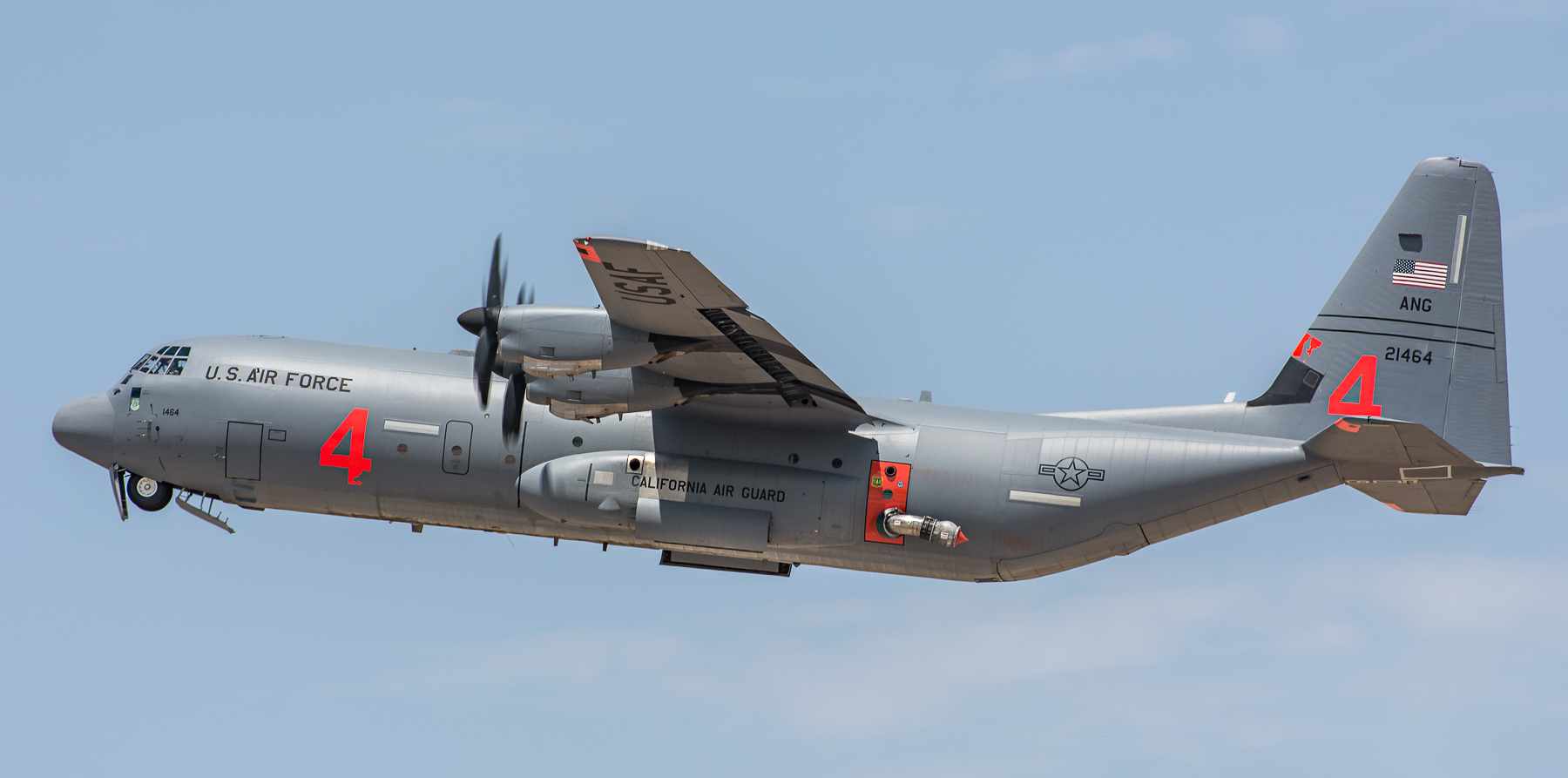
A C-130J-30 Super Hercules from the California ANG configured with the Modular Airborne FireFighting System (MAFFS)
Harvest HAWK
More of a package than a configuration, the Harvest HAWK (Hercules Airborne Weapons Kit) enables USMC KC-130J tankers to provide close air support (CAS) with AGM-114P Hellfire II air-to-ground missiles, MBDA GBU-44/B Viper Strike gliding munitions, Raytheon AGM-175 Griffin short-range air-to-surface missiles and, if needed, a side-mounted Alliant Techsystems Mk 44 Bushmaster 30mm cannon. Future capabilities of the package could include Textron’s 64lb (29kg) Clean Area Weapon (CLAW).
The Harvest HAWK package also utilizes an AN/AAQ-30 Targeting Sight System (TSS) with infrared, electro-optic sensors, and a TV camera, an AGM-114P Hellfire II weapons rack that can carry up to four missiles and a fire control console carried in its cargo compartment.
The Harvest HAWK is considered a roll-on/roll-off kit which means it can easily be installed/removed if the need and the mission changes. With the AN/AAQ-30 TSS, Hellfire weapons rack and the munitions launching “Derringer Door” occupying the left side of the aircraft, the other side can continue to be used for refueling aircraft.
The latest evolution of this package is to include a Wescam MX-20D sensor ball with a laser designator on the nose of the plane, an ALQ-231 Intrepid Tiger II (IT II) electronic warfare pod along with the continued use of Hellfire, Griffin and Viper Strike missiles.
Harvest HAWK-modified KC-130Js were first used in combat in 2010 in Afghanistan. The current goal for the USMC is to have their entire fleet of KC-130Js and their crews be mission ready for the Harvest HAWK package.
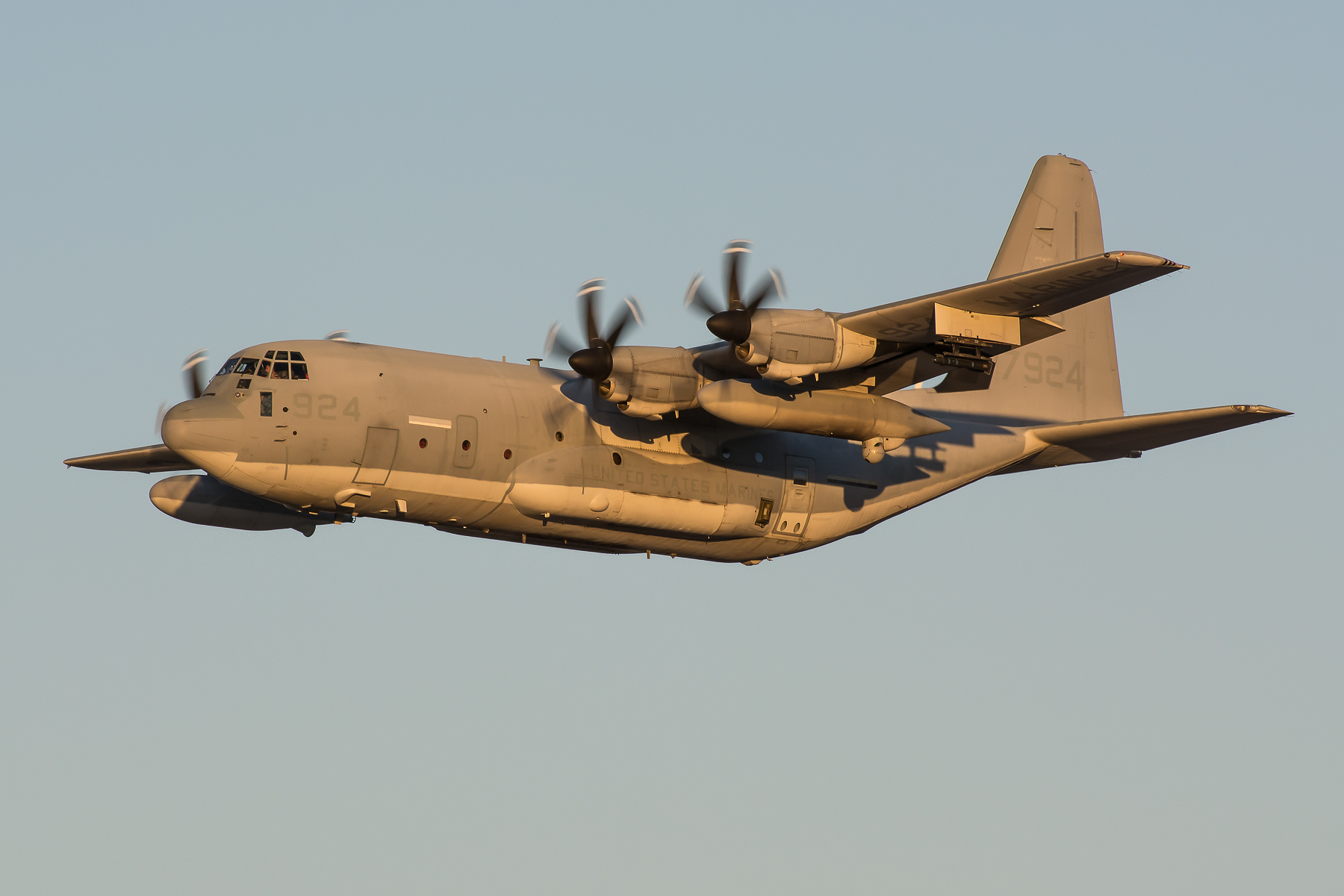
A USMC KC-130J configured with the Harvest HAWK kit
L-100
The L-100 is the civilian version of the C-130 which first received FAA approval in February 1965. While this is a factory designation for civilian use there are many former military C-130’s being used in the civilian sector. 115 L-100s were manufactured by Lockheed from the mid-1960s to early 1990s.
On May 25, 2017, the latest L-100 variant, the L-100J, completed its first flight.
A look at the world’s only Hercules demonstration team. Lockheed Martin Video
Looking Ahead
While the USAF’s Air Mobility Command (AMC) is searching for the next generation airlifter to replace the C-130 and C-17, this aircraft is not expected to be in service until at least 2030. In the meantime, the C-130 Avionics Modernization Program (AMP), supplemented with purchases of the latest C-130J Super Hercules, are expected to meet AMC’s airlift requirements until then.
The C-130 AMP is required not only to modernize the existing C-130 fleet, but to also meet new standards required by the Federal Aviation Administration and the International Civil Aviation Organization. The requirements require avionic upgrades to meet air traffic control standards to communicate with civilian towers and other civilian aircraft. These new standards will impact the C-130 fleet in Europe by 2017 and in the U.S. by 2020. The USAF has argued that even if the C-130 AMP program is fully funded by U.S. Congress, it would only upgrade a portion of the existing fleet by the start of the new requirements.

A Royal Australian Air Force (RAAF) C-130J-30 during Exercise Red Flag 15-1
Internationally, competition from aircraft such as the Airbus A400M Atlas, Embraer KC-390, and others will help drive innovation while getting militaries from around the world to rethink their strategic airlift needs.
For Lockheed Martin, they will continue to produce the C-130J and its variants at a rate of 24 per year out of its Marietta, Georgia facility. Lockheed Martin has delivered more than 375 C-130J Super Hercules to 16 different nations so far; while they continue to innovate by finding new ways to utilize the capabilities of the aircraft… such as with the SC-130J Sea Herc.
According to Lockheed Martin, “The C-130 marked its sixth decade of production in 2014, the longest continuous, active military aircraft line in history. That span covers more than half of the history of powered flight.” With the anticipated U.S. and foreign military sales (FMS) of the “J” models, expect the C-130 to continue its reign as a strategic airlifter for years to come.
In Greek mythology, after the legendary Hercules completed the 12 Labours, many more challenges were presented to him throughout his mortal life. Much like the mythical Hercules, the C-130 continues to show great strength, perseverance and the ability to handle a multitude of challenging missions. In the end, the C-130 will be known as the most versatile military aircraft ever produced…one of which legends are made.
END
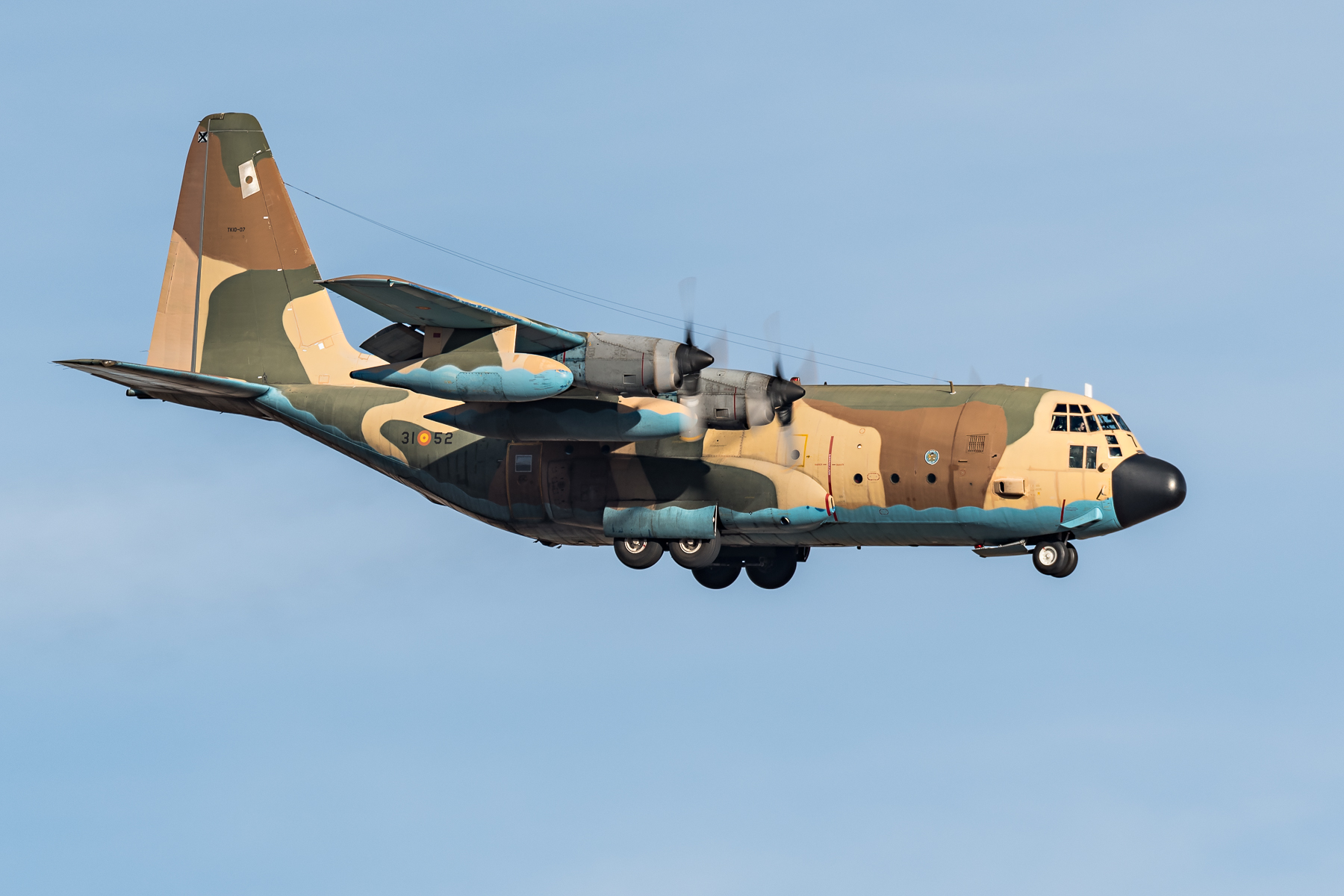
A Spanish Air Force (SPAF) | Ejército del Aire (EdA) KC-130H during Red Flag 17-2
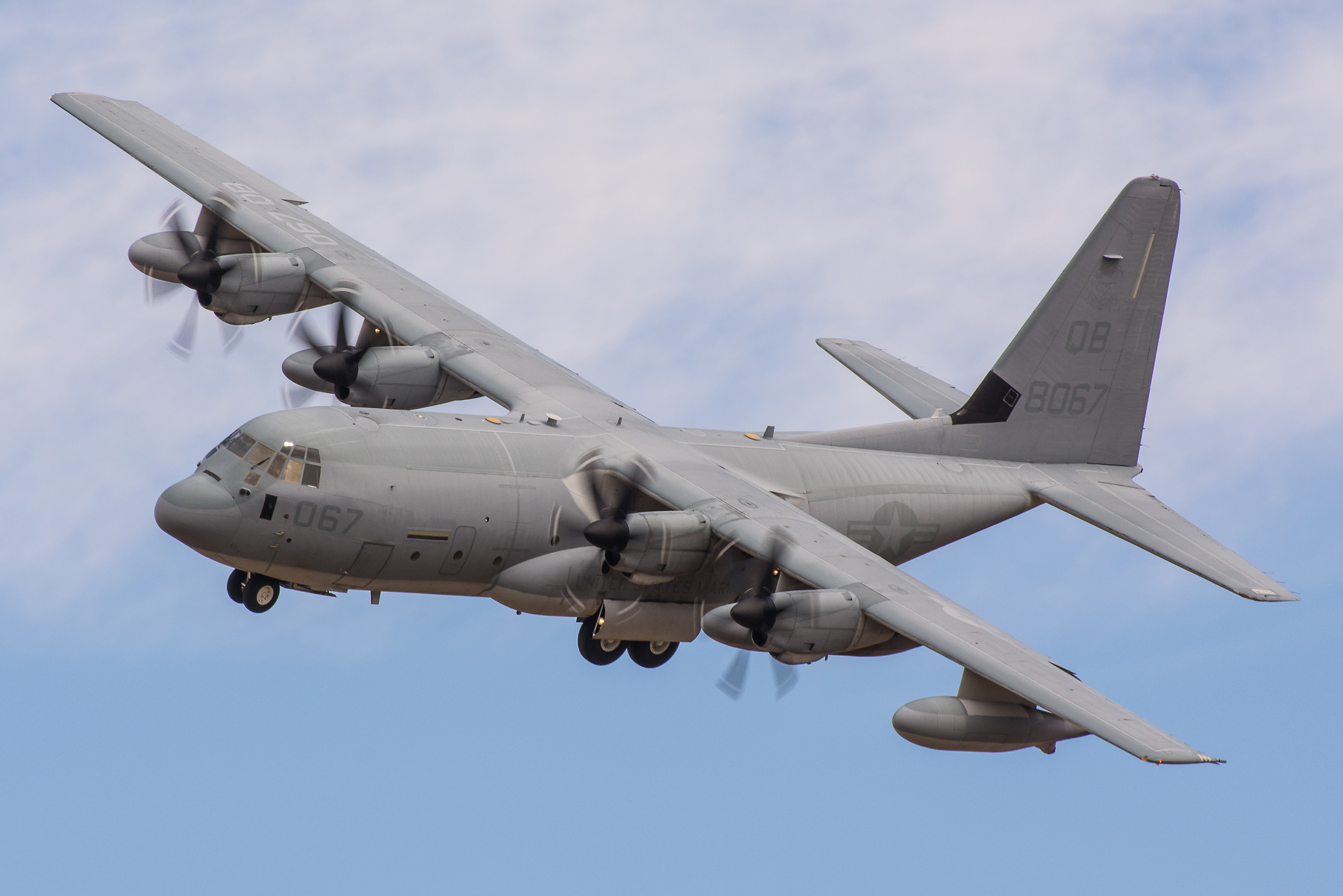
A USMC KC-130J
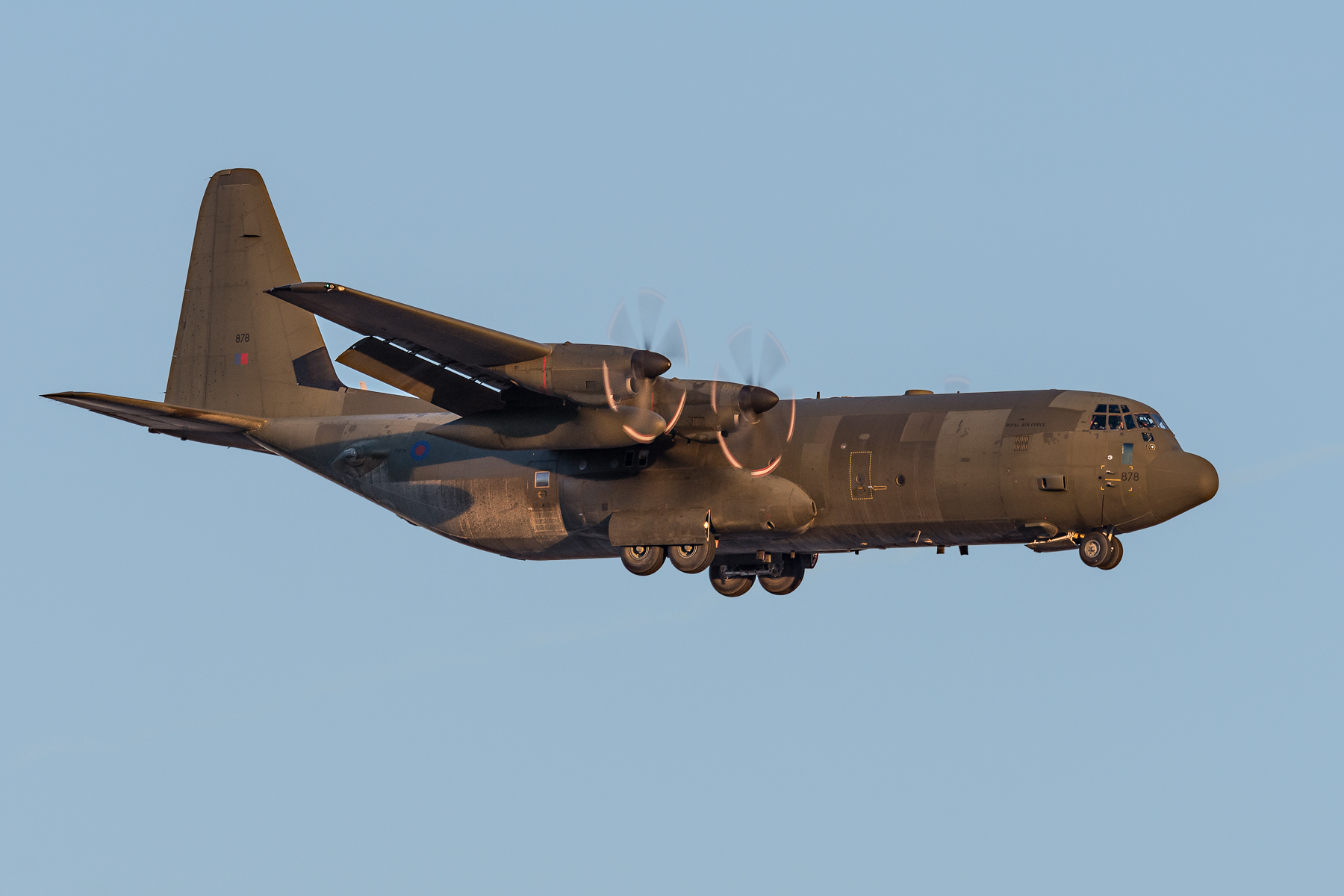
A Royal Air Force (RAF) Hercules C4 (C-130J-30) during Exercise Red Flag 16-1

Looking out the back of a USMC KC-130J while flying a low-altitude mission
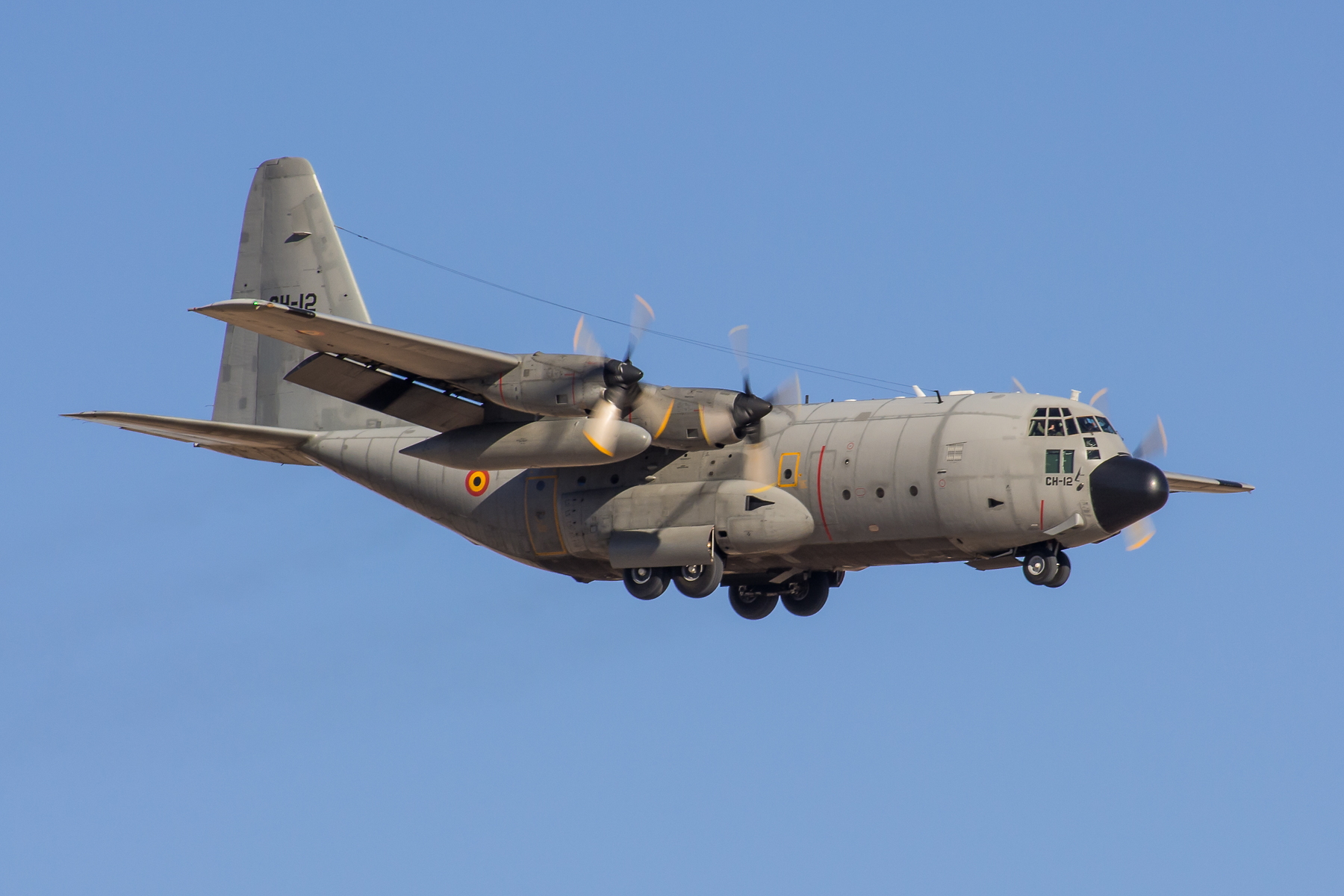
A Belgian Air Component C-130H

A HC-130P Combat Shadow from the 130th Rescue Squadron (130 RQS) of the California Air National Guard

LITENING pod? A C-130H from the 154th Training Squadron (154th TRS) of the Arkansas Air National Guard returns to Davis-Monthan AFB after testing a high-accuracy air drop and reconnaissance system

A USMC KC-130J arriving at NAF El Centro

A HC-130J Combat King II ready to refuel

A RAAF C-130J-30 Super Hercules at Red Flag 15-1

Japan Maritime Self-Defense Force (海上自衛隊, Kaijō Jieitai)(JMSDF) C-130R

A French Air Force (Armée de l’air) C-130H-30

Herc Row – WTI 2-15 – MCAS Yuma, AZ

A C-130H Hercules from the 118th Airlift Squadron (118 AS)

A USMC KC-130J “Raider”
Click on an image below to page or swipe through the gallery:
Steven is from Long Island, New York and now resides in sunny Mesa, Arizona. Steven’s love for aviation began when he was a child with a fascination for WWII aircraft. This love of aviation was further fostered by his uncle, a long-time Trans World Airlines (TWA) employee who had a passion for all forms of aviation.
Steven’s interest in photography began when he was 16 years old when he received his first SLR camera, a Minolta XGA. It makes sense that eventually his passion for aviation and photography would merge into a love for aviation photography.
In addition to being the web designer, webmaster and chief editor of Aviation Photography Digest, Steven has been published in numerous magazines worldwide.
Steven has an M.S. from Boston University and uses Nikon photographic equipment.
Steven is a Nikon NPS member.
Steven can be reached at: [email protected]


